Abstract
Philippine off-grid islands are mostly electrified by diesel generators, resulting in costly electricity that is interrupted by fuel supply disruptions. The archipelagic nature of the country also impedes off-grid electrification due to the high capital cost of grid extension. Transitioning from diesel-only systems to hybrid renewable energy systems and interconnecting the island microgrids can solve these problems while promoting cleaner energy production. In this work, a comparative study on decentralized and clustered hybrid renewable energy system microgrids in the Polillo group of islands in the Philippines, using HOMER Pro, was performed. Microgrids comprising solar photovoltaics, lithium-ion battery energy storage, and diesel generators were designed on each island. Clustered systems encompassing multiple islands in the island group were simulated by also considering the least-cost interconnection paths. The techno-economics of each decentralized or clustered system and the four-island system were evaluated based on the levelized cost of electricity (LCOE). Reliability was assessed using the change in LCOE upon the failure of a component and during weather disturbances. Transitioning from diesel-only systems to hybrid systems reduces generation costs by an average of 42.01% and increases the renewable energy share to 80%. Interconnecting the hybrid systems results in an average increase of 2.34% in generation costs due to the cost of submarine cables but improves system reliability and reduces the optimum solar photovoltaic and lithium-ion storage installations by 6.66% and 8.71%, respectively. This research serves as a framework for the interconnection pre-feasibility analysis of other small off-grid islands.
1. Introduction
Off-grid islands are remote islands that are difficult to connect to the main grid due to the high cost of interconnection. These islands can be found globally, but the Philippines has attracted researchers’ attention due to the numerous islands in the country that may be used in case studies. The electrification of these islands has been the priority of the Philippine Department of Energy (DOE) to promote inclusive socio-economic development in these areas [1,2]. Off-grid islands are often electrified by diesel power plants, which in the Philippines are operated by the National Power Corporation-Small Power Utilities Group (NPC-SPUG) [3]. Diesel plants, however, offer high electricity rates and an unreliable power supply due to price volatility and the logistics of fuel transport [4]. They are also detrimental to the environment due to oil spills, noise pollution, and greenhouse gas emissions [5]. Researchers have therefore investigated the implementation of hybrid renewable energy system (HRES) on these islands.
HRESs are composed of at least one renewable energy (RE) source and may include conventional generation sources, such as diesel generators [6]. RE generation reduces the fuel requirements, while conventional generation addresses the intermittency of RE sources. Energy storage is included to meet peak load demand and to address the mismatch between RE generation and the peak load [7]. HRES is becoming more attractive due to the decreasing cost of solar photovoltaic (PV) and energy storage [8,9]. The decreased reliance on diesel consumption also mitigates economic risks from fuel price shocks [10]. A summary of HRES feasibility studies is presented in Table 1. These works have shown that a transition to a HRES provides more sustainable generation while decreasing the levelized cost of electricity (LCOE).

Table 1.
Summary of studies in hybrid renewable energy systems (HRESs) in off-grid islands.
The reliability of an energy system must also be considered in areas with severe weather events. For example, Typhoon Mankhut forced several diesel generators in Philippine off-grid islands to shut down to prevent damage from distribution line disturbances [17]. System reliability is often quantified based on the failure probability of the energy components [18,19,20,21,22] but may also be measured in terms of cost differences when comparing two energy systems [23]. It is generally observed that HRESs composed of solar PV, energy storage, and diesel generators offer increased reliability [21]. Solar PV and energy storage can power the system when conventional sources, such as diesel generators, are nonfunctional [23]. Bertheau et al. notes, however, that increased reliability often comes with increasing costs [14], so cost optimization must be performed. Nevertheless, an HRES provides lower costs than installing additional diesel generators [19]. A review of the studies on energy system reliability is presented in Table 2.

Table 2.
Summary of studies about energy reliability.
Many studies on HRESs focus solely on decentralized microgrids, which are designed to supply energy to a single off-grid island only [11]. Decentralized electrification, however, has a low investment potential due to the high capital cost and revenue uncertainty [25]. Main grid interconnection has also been investigated. For example, Meschede et al. identified off-grid islands in the Philippines that are viable for main grid interconnection [26]. Cader and Bertheau considered an extreme case wherein all islands are interconnected in the main grid [11]. It was revealed, however, that main grid interconnection is viable only for larger islands [11]. A clustered microgrid, in which the HRESs of multiple islands are interconnected, is proposed as an alternative option. This setup offers increased energy security, reduced energy storage requirements and capital costs per island, and flexibility for RE penetration [27]. Table 3 summarizes studies about interconnection either to the main grid or between islands. Many of these suggest that interconnection decreases generation costs [28,29,30,31,32], but little is known about its impact on reliability. Moreover, the small amount of related literature implies that the economic aspects of interconnection require further study.

Table 3.
Summary of studies about clustered HRESs.
From the previous studies, the techno-economics and reliability of decentralized HRESs in island systems have been studied extensively. However, there exist research gaps on clustered HRESs. In this work, a comparative study between decentralized and clustered HRESs is conducted using the Polillo group of islands in the Philippines as a case study. The analysis of the study was divided into two parts. The techno-economic aspects of clustered and decentralized HRESs are compared in terms of the LCOE. The reliability of the HRES was evaluated by observing the change in LCOE upon the introduction of a disturbance. This study gives insights for private companies and investors for investing in clustered microgrids. Moreover, it provides a simple framework for the modeling of interconnected off-grid islands for pre-feasibility purposes.
2. Materials and Methods
2.1. General Approach
This study considers HRESs consisting of solar PV, lithium-ion (Li-ion) energy storage, and diesel generators only, as this yields a lower LCOE than diesel-only configurations as shown in Appendix A. The optimum sizes and LCOE of an HRES is determined by the HOMER Pro microgrid optimization software. The techno-economic parameters used in the simulations are presented in Appendix B, while the existing generation capacities and generation and demand profiles are in Appendix C. The length of the cables that connect the islands is determined using bathymetric data and the A* algorithm. Decentralized HRESs, which consist of one island only, can be readily optimized by HOMER Pro. Clustered HRESs, which comprise multiple islands, will also require the cable lengths. The techno-economic aspects of the configuration, consisting of all four islands, are evaluated by combining results from the decentralized and clustered HRESs that power the islands. The reliability of an HRES is determined by introducing disturbances into the simulations. Figure 1 summarizes the general approach.
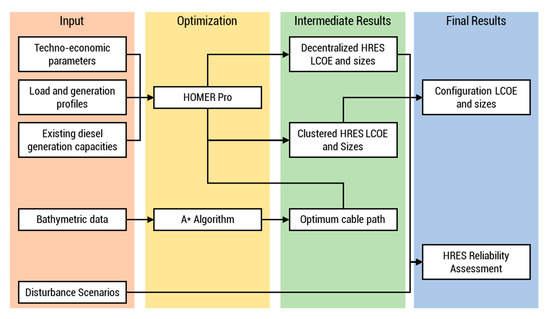
Figure 1.
Flowchart of the general research approach.
2.2. Case Study
The Polillo group of islands comprising Polillo, Palasan, Patnanungan, and Jomalig Islands in Quezon Province, Philippines was considered as the case study (Figure 2). In 2015, the islands registered a total of 53,906 inhabitants and 12,083 households, with Polillo Island constituting approximately 57% of the figures followed by Patnanungan, Jomalig, and Palasan, respectively [33]. The islands are located within the typhoon belt, making them very vulnerable to disasters.
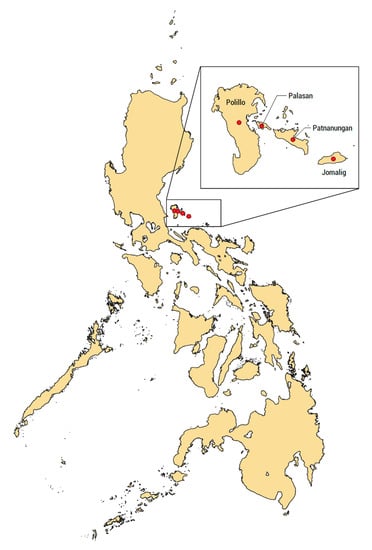
Figure 2.
Location of the selected islands.
2.3. HRES Calculations
2.3.1. A* Algorithm
Island interconnection is performed using submarine and land cables (Table 4). The voltage rating is selected based on the peak load passing through the cable. Due to the linear geographic arrangement of the islands, it was also assumed that the possible connections are only between Polillo and Palasan, Palasan and Patnanungan, and Patnanungan and Jomalig (Figure 3). The path of least cost was obtained using the A* algorithm [34] implemented in Python 3. The A* algorithm determines the path between two points that minimizes a given penalty, which in this case is the cost of the interconnection cables. Note that the path of least cost may be different from the shortest path (i.e., a straight line) due to differences in land and submarine cable costs. The algorithm was selected because it accounts for elevation differences due to the terrain. Bathymetric data in 15 arc-second intervals were obtained from the database of the General Bathymetric Chart of the Oceans [35].

Table 4.
Techno-economic parameters of interconnection cables [11].

Figure 3.
Architecture between the possible interconnections between the selected islands.
2.3.2. HOMER Pro
HOMER Pro accepts the techno-economic parameters, the existing diesel generator capacities, the global horizontal irradiance (GHI) profile, and the load profile at a given site as input. The outputs are the solar PV and Li-ion sizes that minimize the LCOE (, Equation (1)). In this equation, is the discount rate, is the project lifetime (y), is the net present cost (NPC) of the energy system (USD), and is the annual energy demand at the given site (kWh). Details about the calculation of the NPC and other economic data are presented in the HOMER Pro User Manual [36].
Decentralized HRES cover only one island (i.e., one site) and can be optimized directly in HOMER Pro (Figure 4). In contrast, clustered HRESs comprise multiple islands, so the multiple sites must be aggregated into one hypothetical site. If the interconnection losses are neglected, the sum of the load profiles of each island can be taken as the load profile of the clustered HRESs (Equation (2)). The GHI profile of the clustered HRESs is approximated as the average GHI profiles of the connected islands (Equation (3)). The existing generators in each island are modeled individually (Figure 4). In the equations below, is the set of islands connected by the clustered HRESs and is the number of connected islands or the cardinality of . The costs of the interconnection cables are emulated in HOMER Pro by specifying these as the capital or operating costs of the project.
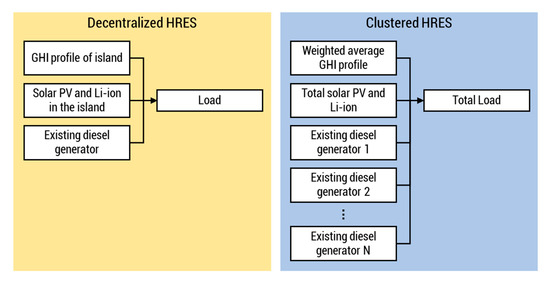
Figure 4.
System architecture simulated in HOMER Pro for decentralized (left) and clustered (right) HRESs.
The optimum sizes and LCOE of a decentralized HRES are taken as those of the island. Meanwhile, the optimum solar PV and Li-ion battery sizes of a clustered HRES are interpreted as the optimum total capacity among the connected islands. The results do not specify the location of the solar PV and Li-ion installations, and are valid even if the capacity is split among the islands because the models are linear with respect to installation size [36]. The impact of interconnection is evaluated by comparing the optimum sizes and LCOE of the clustered HRESs with those of the islands if they were not interconnected. The solar PV size (kW), Li-ion size (kWh), and LCOE (USD/kWh) of the non-interconnected islands are given by Equations (4)–(6), respectively. , , , and are the solar PV size, Li-ion size, LCOE and annual consumption (kWh) of island , respectively. The form of Equation (6) is justified in Appendix D.
2.4. Configuration Calculations
The optimum solar PV (kW) (Equation (7)) and Li-ion (kWh) (Equation (8)) sizes of the configuration (i.e., all four islands) are the sum of the solar PV (kW) and Li-ion (kWh) sizes of each HRES, respectively. In the following equations, is the set of HRES that encompass the four islands.
The LCOE of the configuration is the average LCOE weighted by the annual consumption of each HRES (Equation (9)). and are the LCOE (USD/kWh) and annual consumption (kWh) of HRES . A justification of this equation is provided in Appendix D.
2.5. Reliability
The reliability of an HRES is assessed by recording the percent change in LCOE when a disturbance is introduced , in comparison to the HRES LCOE when the disturbance is absent . This is summarized by Equation (10).
The disturbance scenarios considered in this study and their physical interpretation are summarized in Table 5. Energy component failure is simulated in HOMER Pro by excluding it from the input. The effect of weather disturbances is emulated by setting the GHI values to zero at the given time.

Table 5.
Summary of interconnection scheme of the four-island cluster.
3. Results
3.1. HRES Results
3.1.1. A* Algorithm
The least-distance and least-cost interconnection cable paths are compared in Table 6. The large difference between the least-cost and least-distance paths justifies the use of the algorithm. The cable routes follow the same path regardless of the number of interconnected islands.

Table 6.
Comparison of least-cost path generated by A* (top) and shortest path (bottom).
In the case of the four-island interconnection, the total peak demand of the islands exceeds the peak demand limit and subsequently changes the voltage level of all the submarine cables to be used. A higher cable voltage level slightly increases the interconnection cost as shown in Table 7.

Table 7.
Summary of interconnection scheme of the four-island cluster.
Figure 5 shows the optimized submarine and land cable routes for interconnecting the four islands. The algorithm optimizes the route to avoid costly submarine cables.
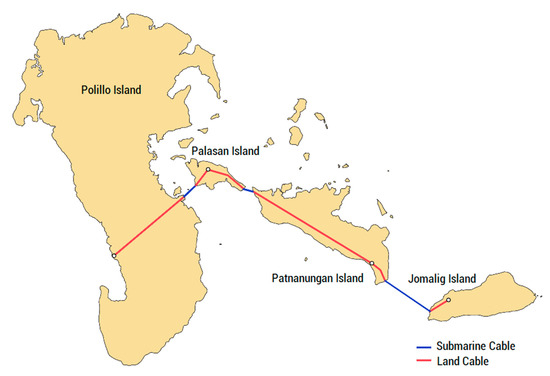
Figure 5.
Optimized land and submarine cable routes between islands.
3.1.2. HOMER Pro
The LCOE generally increases after interconnection (Table 8) due to the capital cost of the cables. The average LCOE increase in all the clustered HRES is 5.71%. However, interconnecting Polillo–Palasan–Patnanungan reduced the LCOE by 1.04% due to the short length of submarine cables.

Table 8.
LCOE of the decentralized and clustered HRES simulations from HOMER Pro.
In contrast, the installation requirements of solar PV and Li-ion battery decreased by 14.56% and 14.45%, respectively, on average (Table 9). The Polillo–Palasan cluster of islands has the highest decrease for both solar PV and Li-ion. Installation requirements decreased upon clustering because excess generation can be sourced from other islands as opposed to increasing the generation capacity. This is justified in Figure 6, wherein the power flow of the Polillo–Palasan cluster and the sum of power flows of the decentralized Polillo and Palasan islands are compared. Larger islands benefit more from this effect because they tend to have more excess generation.

Table 9.
Optimum sizes of the decentralized and clustered HRES simulations from HOMER Pro.

Figure 6.
Power flow of the Polillo–Palasan clustered HRES vs. the sum of the power flows of Polillo and Palasan if they were not connected.
3.2. Configuration Results
The configuration wherein Polillo, Palasan and Patnanungan islands are interconnected while Jomalig island has a standalone energy system (i.e., Po–Pa–Pt Jo configuration) was determined to be the least-cost configuration (Figure 7). The component sizes and LCOE of this configuration are presented in Table 10. It is also observed that a higher degree of interconnection generally leads to smaller component sizes. The configuration wherein all four islands are connected has the lowest solar PV and Li-ion installation requirements.
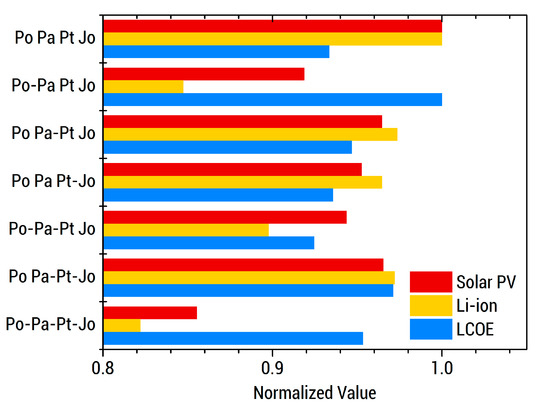
Figure 7.
Optimum sizes and LCOE of different interconnection configurations normalized with respect to the highest value.

Table 10.
Details about the least-cost Po–Pa–Pt Jo configuration.
3.3. Reliability
The reliability of each HRES comprising the least cost configuration (i.e., the clustered Po–Pa–Pt HRES and the decentralized Jo HRES) was analyzed. The extreme case wherein all four islands are interconnected was also considered to demonstrate the effects of interconnection. The system disturbances and the corresponding LCOE response are summarized by Figure 8.
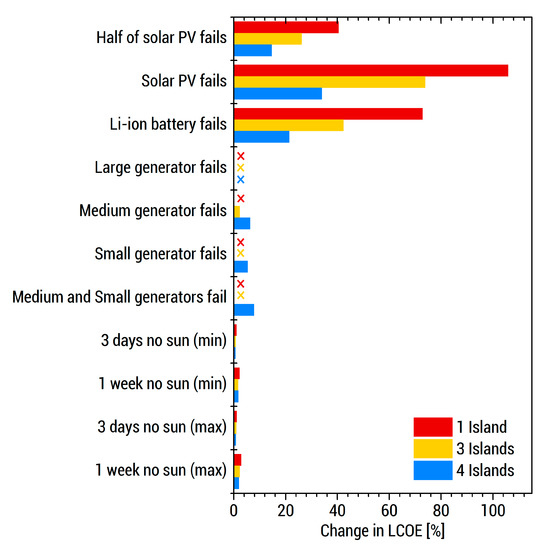
Figure 8.
Change in LCOE when a disturbance is applied to Jomalig decentralized HRES (1 island), the Po–Pa–Pt clustered HRES (3 islands), and the Po–Pa–Pt–Jo clustered HRES (4 islands). An × mark indicates a technically infeasible system.
The lower LCOE changes of the island clusters compared to the standalone energy system demonstrates the advantage of interconnection in terms of reliability. In particular, the clustered HRES, wherein all four islands are interconnected, is the more reliable system. The clustered islands can still provide enough energy when the small or medium generators fail, showing the additional reliability gained from clustering. The HRES fails, however, when the large generator fails because the power generation is insufficient. Storage system failure also alters the LCOE because the system is dependent on Li-ion batteries as seen in the power flow (Figure 9). The component sizes and LCOE of the more reliable HRES are shown in Table 11
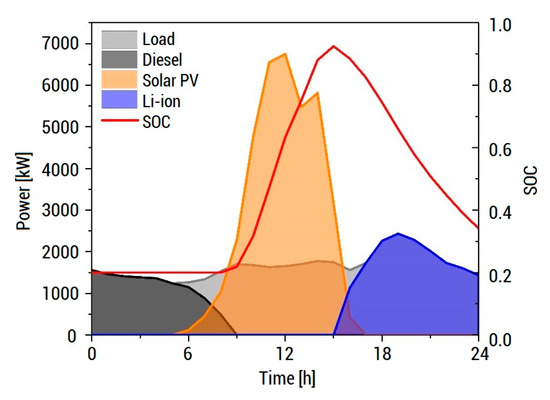
Figure 9.
Power flow of the more reliable HRES without disturbances.

Table 11.
Details about the more reliable HRES.
The highest LCOE increase of 105.81%, 73.86% and 33.97% of the Jo, Po–Pa–Pt, and Po–Pa–Pt–Jo HRESs, respectively, is obtained when both solar PVs fail. The increased diesel consumption during the failure of solar PV causes the increased LCOE. This is evident when comparing the power flow during the partial failure of solar PV (Figure 10) with that of the no-disturbance scenario (Figure 9).
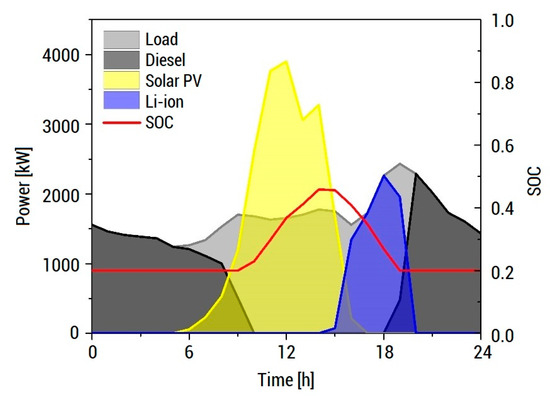
Figure 10.
Power flow of the more reliable HRES when half of the solar capacity fails.
4. Discussion
The Po–Pa–Pt Jo configuration was determined to be the least-cost configuration with an LCOE of 0.417 USD/kWh. In contrast, the more reliable Po–Pa–Pt–Jo configuration with an LCOE of 0.430 USD/kWh offers a better balance between cost and reliability. The LCOE of both configurations, however, is much greater than the 0.1882 USD/kWh, 0.1638 USD/kWh, 0.1664 USD/kWh and 0.2258 USD/kWh power rates charge of QUEZELCO II in Polillo, Patnanungan, Jomalig, and mainland Philippines, respectively [41]. However, the diesel power plants in Patnanungan and Jomalig only operate 16 h a day from 1 p.m. to 5 a.m. [42,43], while the proposed HRES can provide 24/7 access to electricity. It is suggested that Polillo and Patnanungan islands are chosen as the location of the two PV installations due to their large available land areas [44,45].
Electricity generation costs decreased upon transition from diesel-only systems to HRESs. An average LCOE decrease of 42.01% was observed in the Polillo islands. Clustering the HRESs may further decrease the LCOE if the islands are separated by shorter water distances. For example, the Po–Pa–Pt Jo configuration provided a 0.95% decrease in the configuration LCOE. It is more likely, however, that interconnection will increase the LCOE due to the higher capital cost of interconnection. The average configuration-level LCOE increase in the Polillo group of islands is 2.34%. In contrast, installation sizes of solar PV and Li-ion decreased sharply after interconnection. The average decrease was 6.66% and 8.71%, respectively, while the Po–Pa–Pt–Jo configuration yielded a 14.47% and 17.79% decrease, respectively. Higher decreases in generation costs and installation sizes are observed in larger islands [26,27,28,29,30,31,32].
Increasing the degree of interconnection generally increases the generation costs but results in a more reliable system. The standalone Jomalig system failed without the small generator, while the four island Po–Pa–Pt–Jo cluster still provided 24/7 energy access without the small and medium generators. Periods without sun have a minimal effect on generation cost. The failure of solar PV, however, increases the generation costs by 33.97% due to increased diesel reliance. Clustered HRESs can operate despite component failure because power can be drawn from other components instead. However, this mode of operation will require an appropriate control strategy [46].
The results of this study show that it is economical to hybridize and interconnect large islands. This observation is consistent with the state of small island electrification projects in the Philippines. For example, FP Island, owned by the First Philippines Holdings Corp., will operate a total of 1.52 MW of solar PV in Garchitorena, Lahuy and Haponan islands in Caramoan, Camarines Sur [47,48]. WEnergy Global Fund also invested in a 1.4-MW solar PV, 2.4-MWh battery storage, and 1.2-MW diesel generator system in Cabuyagan island, Palawan [49]. Though the number of HRES projects continues to rise, such as that proposed by Siemens Gamesa in Puerto Galera Island, Mindoro [50], funding is still inaccessible [51] due to the low economic returns of off-grid projects [52]. Interconnecting nearby islands can decrease the capital costs per islands, thereby reducing the barrier to energy access [53].
The study provides several insights for future projects. Transitioning to HRESs can improve rural electrification by providing 24/7 access to electricity. Investing in the decentralized hybridization of larger islands is more feasible as it is easier to hybridize. A clustered HRES is another viable option, especially for islands that are close together and are separated by shorter water distance, since it also adds to the system reliability. Reliability slightly increases the cost of electricity; however, it provides greater energy security for the islands. To maximize the potential of the off-grid investment, cost consideration is still crucial [52].
5. Conclusions
In this work, a framework for the modeling of island interconnection was proposed. The framework can be easily adapted into existing microgrid simulation software, HOMER Pro. Interconnection between the Polillo group of islands was analyzed, and the following observations were found:
- Interconnection generally increases the system reliability and decreases installation sizes in exchange of a higher LCOE due to the high interconnection costs. If the islands are closer together, however, then the LCOE may decrease.
- The Po–Pa–Pt Jo configuration provides the lowest costs because the long Pt–Jo interconnection line is excluded. This configuration also yields a lower LCOE than the decentralized Po Pa Pt Jo configuration.
- The Po–Pa–Pt–Jo configuration offers better reliability and has the lowest required installations of solar PV and Li-ion due to the higher degree of interconnection. However, the LCOE is slightly higher than the decentralized configuration.
- The Po–Pa Pt Jo configuration has the lowest cable capital cost, which may be viable if cable capital costs were higher than estimated. The reduction in installation requirements is higher, however, due to the low degree of interconnection.
- Among the selected islands, Palasan is the best place to start investing in HRESs due to the low LCOE. The HRESs installed here can be expanded to the neighboring islands.
The expansion of this analysis to hundreds of Philippine off-grid islands will be performed in future work. A sensitivity analysis on the cost of submarine cables should also be performed. Lastly, the application of the proposed framework can be extended to any small off-grid islands worldwide.
Author Contributions
Conceptualization, methodology, validation, and formal analysis were carried out by O.F.B.A., R.J.A.B., M.E.D.P., M.T.C., and J.D.O. Writing—original draft preparation was conducted by O.F.B.A., R.J.A.B., and M.E.D.P. Writing—review and editing and supervision were carried out by O.F.B.A., R.J.A.B., M.E.D.P., M.T.C., P.B., and J.D.O. Funding acquisition was performed by J.D.O. All authors have read and agreed to the published version of the manuscript.
Funding
This research is part of the Energy Research Fund (ERG) project entitled “ElectriPHI—Electrification Planning in Small Off-grid Islands in the Philippines” funded through the University of the Philippines Office of the Vice-President for Academic Affairs (UP OVPAA) and the Senate Committee on Energy led by Sen. Sherwin T. Gatchalian.
Acknowledgments
The authors would like to acknowledge the help from Jethro Daniel E. Pascasio and Eugene A. Esparcia Jr. J.D.O. would like to acknowledge the Federico Puno Professorial Chair Award and the United States—Association of Southeast Asian Nations (US-ASEAN) Science and Technology Fellowship. M.T.C. would like to acknowledge the Department of Science and Technology Science Education Institute (DOST-SEI) Merit Scholarship Program.
Conflicts of Interest
The authors declare no conflict of interest.
Nomenclature
| CapEx | Capital Expenditures |
| DOE | Department of Energy |
| GHI | Global Horizontal Irradiance |
| HRES | Hybrid Renewable Energy System |
| LCOE | Levelized Cost of Electricity |
| NPC | Net Present Cost |
| NPC–SPUG | National Power Corporation–Small Power Utilities Group |
| OpEx | Operating Expenditures |
| PV | (Solar) Photovoltaic |
| RE | Renewable Energy |
| Po | Polillo Island |
| Pa | Palasan Island |
| Pt | Patnanungan Island |
| Jo | Jomalig Island |
Appendix A
A comparison between the LCOE of diesel-only systems and HRESs is presented in Table A1. The transition from diesel generation to hybrid energy generation yields reduced generation costs and a high contribution of renewable energy. This justifies the sole consideration of HRESs in the study.

Table A1.
Comparison of diesel-only systems and HRESs.
Table A1.
Comparison of diesel-only systems and HRESs.
| System | LCOE (USD/kWh) | Reduction | RE-Share | |
|---|---|---|---|---|
| Diesel | HRES | (%) | (%) | |
| Po | 0.739 | 0.421 | 43.07 | 83.40 |
| Pa | 0.567 | 0.392 | 30.89 | 81.70 |
| Pt | 0.806 | 0.423 | 47.57 | 84.30 |
| Jo | 0.785 | 0.420 | 46.52 | 84.30 |
| Po–Pa | 0.879 | 0.462 | 47.41 | 82.60 |
| Pa–Pt | 0.878 | 0.454 | 48.29 | 83.50 |
| Pt–Jo | 0.907 | 0.426 | 53.03 | 84.60 |
| Po–Pa–Pt | 0.650 | 0.416 | 35.93 | 81.30 |
| Pa–Pt–Jo | 0.589 | 0.477 | 18.89 | 79.40 |
| Po–Pa–Pt–Jo | 0.581 | 0.430 | 25.97 | 77.20 |
Appendix B
The techno-economic parameters of the energy components are shown in Table A2.

Table A2.
Techno-economic parameters used in the simulations.
Table A2.
Techno-economic parameters used in the simulations.
| Component | Parameter | Unit | Value |
|---|---|---|---|
| Solar PV 1 [54] | CapEx | USD/kW | 1800 |
| OpEx | USD/kW-y | 140 | |
| Efficiency | % | 80 | |
| Lifetime | y | 25 | |
| Li-ion 1 [54] | CapEx | USD/kWh | 300 |
| OpEx | USD/kWh-y | 0.10 | |
| RT efficiency 2 | % | 90 | |
| Max. DOD 3 | % | 80 | |
| C-rate | kW/kWh | 1 | |
| Lifetime | y | 15 | |
| Diesel 1 [54] | CapEx | USD/kW | 150 |
| OpEx | USD/kW-y | 0.11 | |
| Fuel Price | USD/L | 1 | |
| Lifetime | h | 15,000 | |
| Project [55] | CapEx | USD | 0 |
| OpEx | USD/y | 0 | |
| Discount rate | % | 3.19 | |
| Lifetime | y | 20 |
1 Adjusted to 2020 using price reduction rate from Bloomberg. 2 Roundtrip efficiency. 3 Maximum depth of discharge.
Appendix C
Appendix C.1. Generation Profiles
The monthly average GHI profiles used by HOMER Pro are presented in Figure A1.
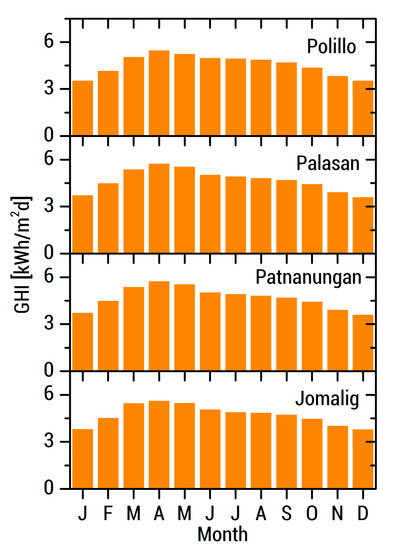
Figure A1.
Monthly average global horizontal irradiance (GHI) profiles in the selected islands.
Appendix C.2. Demand Profiles
The peak demand from 2017 was extrapolated to 2020 at a load growth rate equal to each island’s population growth rate. This was increased by 15% to account for power line losses [56]. The derived peak loads and a summary of each island are shown in Table A3 and Table A4, respectively. To generate the load profile, a generic load profile (Figure A2) is scaled up to meet the peak load

Table A3.
Forecasted peak loads of the islands and their respective population growth rates.
Table A3.
Forecasted peak loads of the islands and their respective population growth rates.
| Island | Pop. Growth | Peak Load (kW) | ||
|---|---|---|---|---|
| Rate (%) | 2017 | 2020 | 2020 + Losses | |
| Polillo | 1.61% | 1708 | 1791 | 2060 |
| Palasan | 1.91% | 41.24 | 43.71 | 50.27 |
| Patnanungan | 1.00% | 427.61 | 440.62 | 506.71 |
| Jomalig | 1.43% | 271.30 | 283.14 | 325.61 |

Table A4.
Relevant parameters about each island.
Table A4.
Relevant parameters about each island.
| Island | Coordinates | Existing Diesel (kW) | Peak Load (kW) | Annual Load (MWh) |
|---|---|---|---|---|
| Polillo | 14.87° N; 121.94° E | 4263 | 2061 | 10,236 |
| Palasan | 14.86° N; 122.04° E | 0 | 50 | 250 |
| Patnanungan | 14.79° N; 122.19° E | 1059 | 507 | 2517 |
| Jomalig | 14.70° N; 122.38° E | 616 | 326 | 1617 |
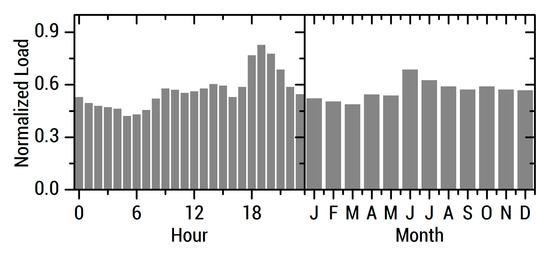
Figure A2.
Daily and monthly average of the normalized load profile.
Appendix D
Consider an agglomeration of HRES each with an annual energy consumption and an LCOE of . It is desired to determine the LCOE of the agglomeration (Equation (A1)) in terms of the parameters given earlier. In Equation (A1), and refer to the NPC and annual energy consumption of the agglomeration.
The NPC of the agglomeration is the sum of the net present cost of each HRES NPC (Equation (A2)). Similarly, the annual consumption of the agglomeration is the sum of the annual consumption of each HRES (Equation (A3)).
The NPC of an HRES is related to its LCOE (Equation (A4)).
Substitute Equation (A4) into Equation (A2) to yield Equation (A5).
Finally, substitute Equation (A3) and Equation (A5) into Equation (A1) to yield Equation (A6). This equation states that the LCOE of an agglomeration is the average LCOE of each HRES weighted with respect to the annual energy consumption.
References
- Roxas, F.Y.; Santiago, A.L. A New Systems Paradigm for the Rural Electrification Program, Philippines; Technical Report; U.S. Department of Energy Office of Scientific and Technical Information: Tennessee, TN, USA, 2010; pp. 1–17.
- Olap, M.L.L. Total Electrification Strategy for 100% Household Electrification of the Philippines by 2022. In Proceedings of the 4th International Off-Grid Renewable Energy Conference, Singapore, 1 November 2018. [Google Scholar]
- National Power Corporation NPC Now. Available online: https://www.napocor.gov.ph/index.php/about-us/who-we-are/revised-npc-charter-ra-6395 (accessed on 7 August 2020).
- Ocon, J.D.; Bertheau, P. Energy Transition from Diesel-based to Solar Photovoltaics-Battery-Diesel Hybrid System-based Island Grids in the Philippines—Techno-Economic Potential and Policy Implication on Missionary Electrification. J. Sustain. Dev. Energy Water Environ. Syst. 2019, 7, 139–154. [Google Scholar] [CrossRef]
- Intergovernmental Panel on Climate Change. Climate Change 2014: Synthesis Report. Contribution of Working Groups I, II and III to the Fifth Assessment Report of the Intergovernmental Panel on Climate Change; IPCC: Geneva, Switzerland, 2014. [Google Scholar]
- Lazarov, V.D.; Notton, G.; Zarkov, Z.; Bochev, I. Hybrid Power Systems with Renewable Energy Sources—Types, Structures, Trends for Research and Development. In Proceedings of the Eleventh International Conference оn Electrical Machines, Drives аnd Power Systems ELMA 2005, Sofia, Bulgaria, 15–16 September 2005; Volume 1, p. 886. [Google Scholar]
- Deshmukh, M.K.; Deshmukh, S.S. Modeling of hybrid renewable energy systems. Renew. Sustain. Energy Rev. 2008, 12, 235–249. [Google Scholar] [CrossRef]
- Schmidt, O.; Hawkes, A.; Gambhir, A.; Staffell, I. The future cost of electrical energy storage based on experience rates. Nat. Energy 2017, 2, 1–8. [Google Scholar] [CrossRef]
- Schmidt, O.; Melchior, S.; Hawkes, A.; Staffell, I. Projecting the Future Levelized Cost of Electricity Storage Technologies. Joule 2019, 3, 81–100. [Google Scholar] [CrossRef]
- Manetsgruber, D.; Wagemann, B.; Kondev, B.; Dziergwa, K. Risk Management for Mini-Grids: A New Approach to Guide Mini-Grid Deployment; Verlag Nicht Ermittelbar: Brussels, Belgium, 2015. [Google Scholar]
- Bertheau, P.; Cader, C. Electricity sector planning for the Philippine islands: Considering centralized and decentralized supply options. Appl. Energy 2019, 251, 113393. [Google Scholar] [CrossRef]
- Bertheau, P.; Blechinger, P. Resilient solar energy island supply to support SDG7 on the Philippines: Techno-economic optimized electrification strategy for small islands. Util. Policy 2018, 54, 55–77. [Google Scholar] [CrossRef]
- Dejucos, M.A.R.; Esparcia, E.A.; Ocon, J.D. Waste biomass integration to reduce fuel consumption and levelized cost of electricity in Philippine off-grid islands. Chem. Eng. Trans. 2019, 76, 943–948. [Google Scholar]
- Bertheau, P. Supplying not electrified islands with 100% renewable energy based micro grids: A geospatial and techno-economic analysis for the Philippines. Energy 2020, 202, 117670. [Google Scholar] [CrossRef]
- Pascasio, J.D.A.; Esparcia, E.J.A.; Odulio, C.M.F.; Ocon, J.D. High Renewable Energy (Solar Photovoltaics and Wind) Penetration Hybrid Energy Systems for Deep Decarbonization in Philippine Off-grid Areas. Chem. Eng. Trans. 2019, 76, 1135–1140. [Google Scholar]
- Blechinger, P.; Cader, C.; Bertheau, P.; Huyskens, H.; Seguin, R.; Breyer, C. Global analysis of the techno-economic potential of renewable energy hybrid systems on small islands. Energy Policy 2016, 98, 674–687. [Google Scholar] [CrossRef]
- National Power Corporation Napocor Restores Power to Typhoon Ompong Affected Islands and Off-Grid Areas. Available online: https://www.napocor.gov.ph/index.php/psalm-electricity-rates/35-press-release/453-napocor-restores-power-to-typhoon-ompong-affected-islands-and-off-grid-areas (accessed on 7 August 2020).
- Cepin, M. Assessment of Power System Reliability: Methods and Applications; Springer: London, UK; Dordrecht, The Netherlands; Heidelberg, Germany; New York, NY, USA, 2011; ISBN 9780857296870. [Google Scholar]
- Kumar, N.M.; Ghosh, A.; Chopra, S.S. Power Resilience Enhancement of a Residential Electricity User Using Photovoltaics and a Battery Energy Storage System under Uncertainty Conditions. Energies 2020, 13, 4193. [Google Scholar] [CrossRef]
- Khare, V.; Nema, S.; Baredar, P. Reliability analysis of hybrid renewable energy system by fault tree analysis. Energy Environ. 2019, 30, 542–555. [Google Scholar] [CrossRef]
- Żelazna, A.; Gołębiowska, J.; Zdyb, A.; Pawłowski, A. A Hybrid vs. On-Grid Photovoltaic System: Multicriteria Analysis of Environmental, Economic, and Technical Aspects in Life Cycle Perspective. Energies 2020, 13, 3978. [Google Scholar] [CrossRef]
- Ouyang, M.; Dueñas-Osorio, L. Multi-dimensional hurricane resilience assessment of electric power systems. Struct. Saf. 2014, 10, 933. [Google Scholar] [CrossRef]
- Anderson, K.; Laws, N.D.; Marr, S.; Lisell, L.; Jimenez, T.; Case, T.; Li, X.; Lohmann, D.; Cutler, D. Quantifying and monetizing renewable energy resiliency. Sustainability 2018, 10, 933. [Google Scholar] [CrossRef]
- Shivaie, M.; Mokhayeri, M.; Kiani-Moghaddam, M.; Ashouri-Zadeh, A. A reliability-constrained cost-effective model for optimal sizing of an autonomous hybrid solar/wind/diesel/battery energy system by a modified discrete bat search algorithm. Sol. Energy 2019, 189, 344–356. [Google Scholar] [CrossRef]
- Bertheau, P.; Dionisio, J.; Jütte, C.; Aquino, C. Challenges for implementing renewable energy in a cooperative-driven off-grid system in the Philippines. Environ. Innov. Soc. Transit. 2020, 35, 333–345. [Google Scholar] [CrossRef]
- Meschede, H.; Esparcia, E.A.; Holzapfel, P.; Bertheau, P.; Ang, R.C.; Blanco, A.C.; Ocon, J.D. On the transferability of smart energy systems on off-grid islands using cluster analysis—A case study for the Philippine archipelago. Appl. Energy 2019, 251, 113290. [Google Scholar] [CrossRef]
- Lobato, E.; Sigrist, L.; Rouco, L. Value of electric interconnection links in remote island power systems: The Spanish Canary and Balearic archipelago cases. Int. J. Electr. Power Energy Syst. 2017, 91, 192–200. [Google Scholar] [CrossRef]
- Zafeiratou, E.; Spataru, C. Potential economic and environmental benefits from the interconnection of the Greek islands. International Journal Of Global Warming. Int. J. Glob. Warm. 2017, 13, 426–458. [Google Scholar] [CrossRef]
- Georgiou, P.N.; Mavrotas, G.; Diakoulaki, D. The effect of islands’ interconnection to the mainland system on the development of renewable energy sources in the Greek power sector. Renew. Sustain. Energy Rev. 2011, 15, 2607–2620. [Google Scholar] [CrossRef]
- Pean, E.; Pirouti, M.; Qadrdan, M. Role of the GB-France electricity interconnectors in integration of variable renewable generation. Renew. Energy 2016, 99, 307–314. [Google Scholar] [CrossRef]
- Denny, E.; Tuohy, A.; Meibom, P.; Keane, A.; Flynn, D.; Mullane, A.; O’Malley, M. The impact of increased interconnection on electricity systems with large penetrations of wind generation: A case study of Ireland and Great Britain. Energy Policy 2010, 38, 6946–6954. [Google Scholar] [CrossRef]
- Ries, J.; Gaudard, L.; Romerio, F. Interconnecting an isolated electricity system to the European market: The case of Malta. Util. Policy 2016, 40, 1–14. [Google Scholar] [CrossRef]
- Philippine Statistics Authority. 2015 Census of Population; Philippine Statistics Authority: Quezon City, Philippines, 2015.
- Lester, P. A* Pathfinding for Beginners; Pace University Seidenberg School: New York, NY, USA, 2005; pp. 1–11. [Google Scholar]
- GEBCO Bathymetric Compilation Group The GEBCO 2020 Grid. Available online: https://www.gebco.net/data_and_products/gridded_bathymetry_data/ (accessed on 7 August 2020).
- HOMER Energy HOMER Pro 3.13 User Manual. Available online: https://www.homerenergy.com/products/pro/docs/latest/index.html (accessed on 7 August 2020).
- Rajput, P.; Malvoni, M.; Kumar, N.M.; Sastry, O.S.; Tiwari, G.N. Risk priority number for understanding the severity of photovoltaic failure modes and their impacts on performance degradation. Case Stud. Therm. Eng. 2019, 16, 100563. [Google Scholar] [CrossRef]
- Tahmasbi, A.A.; Eikerling, M.H. Statistical physics-based model of mechanical degradation in lithium ion batteries. Electrochim. Acta 2018, 283, 75–87. [Google Scholar] [CrossRef]
- Wang, Q.; Mao, B.; Stoliarov, S.I.; Sun, J. A review of lithium ion battery failure mechanisms and fire prevention strategies. Prog. Energy Combust. Sci. 2019, 73, 95–131. [Google Scholar] [CrossRef]
- Ramabhotla, S.; Bayne, S.B.; Flack, T.J.; Giesselmann, M. Reliability Optimization in the Islanded Mode of Microgrid. J. Energy Power Eng. 2017, 11, 103–114. [Google Scholar]
- QUEZELCO QUEZELCO II. Available online: http://www.quezelco2.com.ph/ (accessed on 7 August 2020).
- Patnanungan DPP. Available online: https://www.napocor.gov.ph/index.php/services/missionary-electrification/spug-plants/45-missionary-electrification/luzon/mqnlod/325-patnanungan-dpp (accessed on 25 May 2020).
- Jomalig DPP. Available online: https://www.napocor.gov.ph/index.php/services/missionary-electrification/spug-plants/45-missionary-electrification/luzon/mqnlod/324-jomalig-dpp (accessed on 25 May 2020).
- Islands.unep.ch. 2020. Available online: http://islands.unep.ch/Tiarea.htm (accessed on 28 May 2020).
- Overview—Google Earth. Google Earth. 2020. Available online: https://www.google.com/earth/ (accessed on 28 May 2020).
- Hussain, A.; Bui, V.H.; Kim, H.M. Microgrids as a resilience resource and strategies used by microgrids for enhancing resilience. Appl. Energy 2019, 240, 56–72. [Google Scholar] [CrossRef]
- Energy Regulatory Commission. ERC Case No. 2019-027 RC; Energy Regulatory Commission: Pasig City, Philippines, 2019.
- Lagare, J. DOE Endorses 10 Power Projects. Available online: https://www.manilatimes.net/2019/06/03/business/business-top/doe-endorses-10-power-projects/563659/ (accessed on 7 August 2020).
- Burger, A. Cleangrid Partners Inagurates Microgrid in the Philippines. Available online: https://microgridknowledge.com/cleangrid-philippines-microgrid/ (accessed on 7 August 2020).
- Chakraborty, A. Siemens Gamesa to Deliver Hybrid Plant in the Philippines. Available online: https://www.power-technology.com/news/siemens-gamesa-hybrid-plant-philippines/ (accessed on 7 August 2020).
- Bhattacharyya, S.C. Financing energy access and off-grid electrification: A review of status, options and challenges. Renew. Sustain. Energy Rev. 2013, 20, 462–472. [Google Scholar] [CrossRef]
- IRENA. Mini-Grid Deployment: A Study on the Philippines; International Renewable Energy Agency: Masdar City, Abu Dhabi, UAE, 2017; ISBN 9789292600303. [Google Scholar]
- Mohapatra, D.; Jaeger, J.; Wiemann, M. Private Sector Driven Business Models for Clean Energy Mini-Grids Lessons Learnt from South and South-East-Asia; Alliance for Rural Electrification: Brussels, Belgium, 2019. [Google Scholar]
- Fajilagutan, R. The Case of Cobrador Island, Romblon, Romblon; ROMELCO: Romblon, Philippines, 2015. [Google Scholar]
- Philippine Inflation Rate 1960–2020. Available online: https://www.macrotrends.net/countries/PHL/philippines/inflation-rate-cpi (accessed on 7 August 2020).
- National Assocation of Clean Air Agencies. Implementing EPA’s Clean Power Plan; National Assocation of Clean Air Agencies: Washington, DC, USA, 2015; p. 465. [Google Scholar]
© 2020 by the authors. Licensee MDPI, Basel, Switzerland. This article is an open access article distributed under the terms and conditions of the Creative Commons Attribution (CC BY) license (http://creativecommons.org/licenses/by/4.0/).